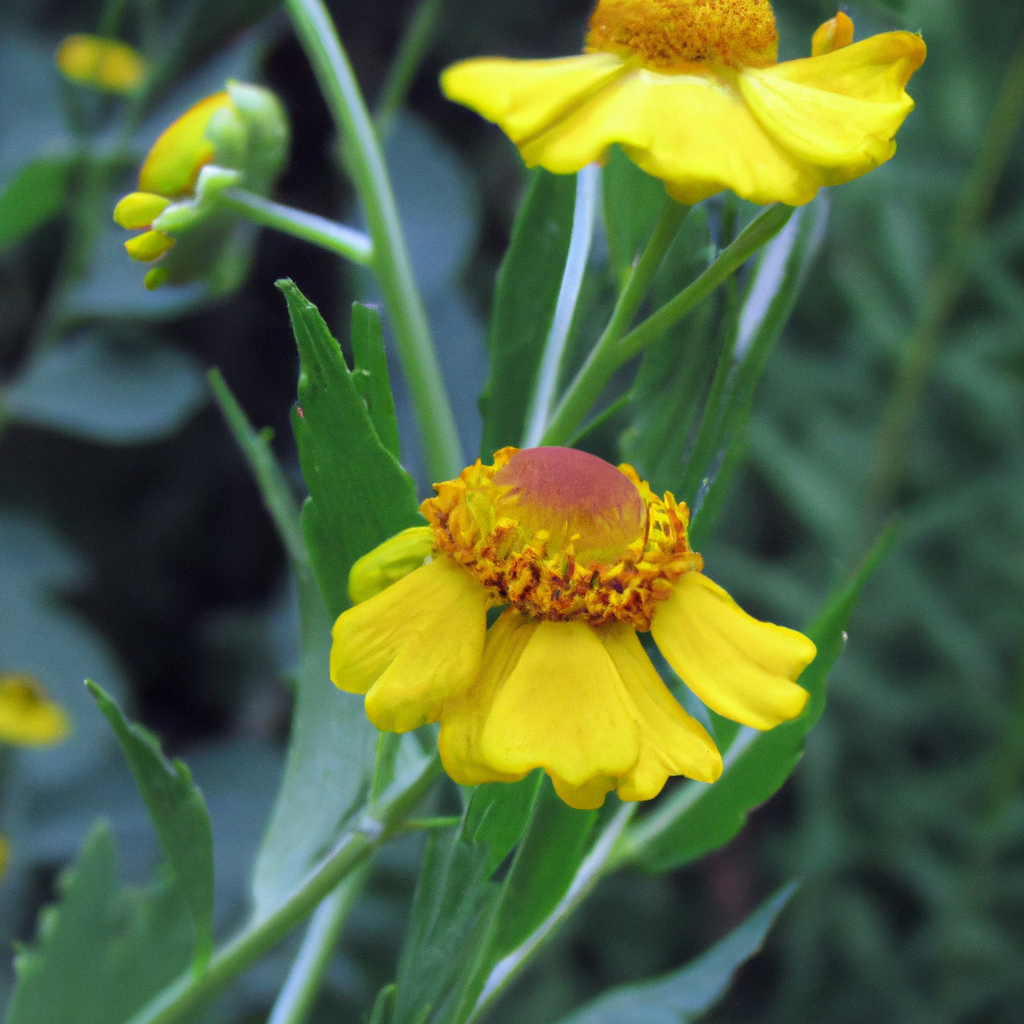Biological Name:
Helenium amarum (Southern-Sneezeweed)
Natural Habitat:
Southern-Sneezeweed: This plant is native to North America and can be found in a variety of habitats, including wetlands, stream banks, and damp meadows.
Description:
Southern-Sneezeweed also known as Helenium is a plant that is native to grassland and prairie regions of North America. It is an annual herb that can grow up to three feet tall and it has small oval-shaped leaves and showy yellow or orange flowers that bloom in the summer. The plant is known for its ability to cause sneezing when the flowers are crushed and it is often used as an ornamental plant in gardens and landscapes.
Frequently Asked Questions (FAQs)
Q: What is sneezeweed good for?
A: Medicinal use of Sneezeweed: The dried nearly mature flower heads are used in a powdered form as a snuff to treat colds and headaches. When made into a tea they are used in the treatment of intestinal worms. The powdered leaves are sternutatory. An infusion of the leaves is laxative and alterative.
Source
Q: Is sneezeweed poisonous?
A: All plant parts are poisonous. Sneezeweed grows at elevations of 1500 to 4,000 meters on moist slopes and well-drained meadows from western Montana and eastern Oregon southward to California and New Mexico. It starts growing in early spring and matures in the late summer and early fall.
Source
Q: When should I start my Sneezeweed seeds?
A: Sow indoors 8-10 weeks before planting out in early spring when the soil is cool and light frost is still possible. Or direct sow in early spring or early autumn. The ideal temperature for germination is 21°C (70°F). Seeds will sprout in 7-10 days.
Source
Q: Do heleniums need deadheading?
A: Caring for heleniums Deadhead blooms to keep the flowers coming, or cut flowers to bring indoors. Clumps can become a bit congested after a few years, so will need dividing in autumn or spring. Taller varieties are worth staking early in the season.
Source
Q: Is sneezeweed drought tolerant?
A: This species prefers loamy or silty soils that are high in organic matter. Plants thrive in wet or evenly moist soil but will tolerate a bit of drought after establishment.
Source
Q: Does sneezeweed need full sun?
A: Sneezeweed can be cultivated in average to rich soils, needing moist to wet conditions and full sun. The plants often become so tall they need staking or other support. Alternatively, they can be cut back in early summer (that is, late June or early July) to force shorter, more-branched flowering heads.
Source
Q: Do you cut back sneezeweed in winter?
A: When and how to prune helenium ( sneezeweed). Cut back the dead stems to ground level in late winter.
Source
Q: Is sneezeweed an annual or perennial?
A: Common Sneezeweed, False Sunflower, Helen’s Flower, Yellow Star (Helenium) Native to North America and Central America, Helenium is a great perennial for the late-season garden as it provides weeks of splashes of color, from early summer to early fall, when many other perennials are starting to fade.
Source
Q: How do you winterize sneezeweed?
A: 6 Spread a 6-inch layer of hay over sneezeweed plants just after the first frost of winter. This will insulate the soil and prevent continual freezing and thawing cycles, which can damage the plant. Remove the hay in early spring to allow growth to resume.
Source
Q: Can sneezeweed be divided?
A: After blooming, cut the flower stalks down to the foliage. Divide plants in the spring or fall every three to five years to keep plants vigorous.
Source
Q: How do you take care of sneezeweed?
A: Care of Sneezeweed Plants They need rich, moist, or wet soil in a location with full sun. Unless the soil is poor, the plants won’t need supplemental fertilizer. Compact plants are easier to grow than the 4 to 5 foot (1-1.5 m.) tall varieties.
Source
Q: Is sneezeweed invasive?
A: This species does not appear on any state or national invasive species lists.
Source
Q: Should I cut back sneezeweed?
A: Sneezeweed (Helenium autumnale) Doesn’t finish blooming until mid-fall. The foliage can be cut back and removed when it’s done blooming.
Source
Q: How toxic is sneezeweed to livestock?
A: An animal may die if it eats small quantities of sneezeweed over a long period. Eating about 1 kg of green sneezeweed leaves daily for 10 days may poison sheep. Some animals die within a few days after first signs appear. Others that develop a chronic form of poisoning may live for 2 to 3 weeks.
Source
Q: How do you get rid of sneezeweed?
A: Bitter sneezeweed can be controlled with herbicides. Mowing will reduce seed production but generally is not effective in killing this plant. Hand weeding is effective to remove small infestations. Consult your local Cooperative Extension Service personnel for herbicidal control in your area.
Source
Q: Do helenium come back every year?
A: Heleniums die back over winter, so cut them back after flowering.
Source
Q: When should I cut back helenium?
A: Heleniums generally need staking to keep them upright, but to avoid this you can give them the ‘Chelsea chop’, in May, or cut them back to 30cm (12in) in mid-July. This delays flowering slightly but keeps plants more compact so you can enjoy the flowers on neat, unstaked plants.
Source
Q: Is sneezeweed Hardy?
A: Culture: Frost hardy, they prefer full sun (at least 6 hours of direct sun), well, drained soil and regular water. Propagate from seed or by division in early spring. Heleniums are hardy in zones 3-9.
Source

